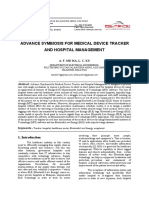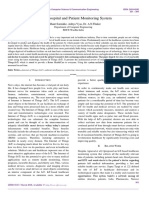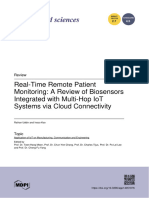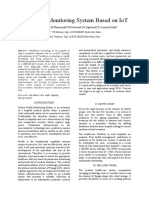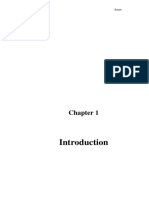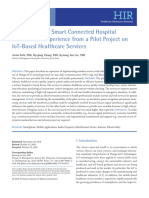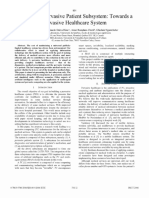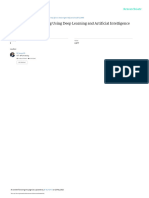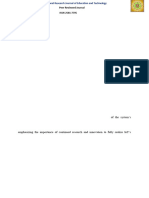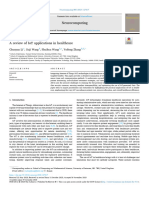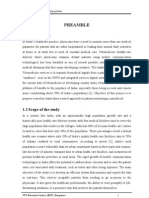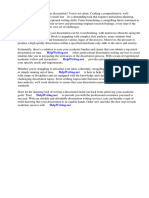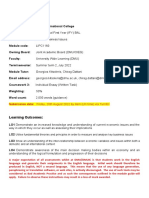Design and Development of Low Investment Smart Hospital Using Internet of Things Through Innovative Approaches
Design and Development of Low Investment Smart Hospital Using Internet of Things Through Innovative Approaches
Uploaded by
Bhind Raj PandeyCopyright:
Available Formats
Design and Development of Low Investment Smart Hospital Using Internet of Things Through Innovative Approaches
Design and Development of Low Investment Smart Hospital Using Internet of Things Through Innovative Approaches
Uploaded by
Bhind Raj PandeyOriginal Description:
Copyright
Available Formats
Share this document
Did you find this document useful?
Is this content inappropriate?
Copyright:
Available Formats
Design and Development of Low Investment Smart Hospital Using Internet of Things Through Innovative Approaches
Design and Development of Low Investment Smart Hospital Using Internet of Things Through Innovative Approaches
Uploaded by
Bhind Raj PandeyCopyright:
Available Formats
Biomedical Research 2017; 28 (11): 4979-4985 ISSN 0970-938X
www.biomedres.info
Design and development of low investment smart hospital using internet of
things through innovative approaches.
Patan Rizwan1, Rajasekhara Babu M1*, Suresh K2
1School of Computer Science and Engineering, VIT University, Vellore, India
2Department of CSE, Annamacharya Institute of Technology and Sciences, Rajampet, Kadapa (Dt), Andhra Pradesh,
India
Abstract
Currently smart hospitals are very few as well as very expansive. The cost of these smart hospital set up
can be reduced by deploying Internet of Things (IoT). IoT is booming technology in many fields for
smart environments. This paper presents an innovative technical support for development of smart
hospitals with low investment. Automation in dealing with medical things reduces the human
intervention. Patient remote monitoring system monitors the chronic disease patient’s health condition
continuously and generates alerts during abnormal situations of patient’s health. A Patient remote
monitoring system includes wearable devices which are developed by using Internet of Things. The
wearable devices track the patients’ health condition continuously. In addition, the hospital beds
equipped with sensors that measure patient’s vital signs that can be converted to deploy as Internet of
Medical Things (IoMT) technology. Finally, the proposed model built with very limited capital that
provides better service for all kind of peoples.
Keywords: Smart hospitals, Internet of things, Wireless sensors, Real-time device control.
Accepted on March 30, 2017
Introduction never been greater. The increased focus on value-based care is
shifting financial incentives to a model in which providers are
In a hospital, the Internet of Things (IoT) is made up of compensated based on how their patients fare, rather than by
Internet Protocol (IP) addressable communications and sensor the number of tests [1], number of visits, or performed
systems, medical devices, hospital information systems and procedures. This means that patients, providers and everyone
building systems, such as the electronic medical record. These in between are additional eager than ever to measure patient
are all integrated through an enterprise service bus that allows outcomes in order to determine what works and who gets paid.
all of these disparate systems to exchange data with each other
and with staff, healthcare providers and patients. The Internet Figure 1 shows that common hospital required facilities. It
of Medical Things (IoMT) is fundamentally changing the shows clearly category wise support required to the patients as
delivery of healthcare by information exchange and unifying well as hospital staffs. In this frame work showing their
communications in unparalleled ways, and delivering the right highlight boxes type of support required. This all are clearly
information and resources at the right time to the point of care. categorized in the diagrams form patient entry to leaving from
The grouping of bidirectional communication between building the hospital, what type of facilities to be required for reducing
systems, clinical and business, the operation of smart, semi- their delay, providing feasibility. To becoming a smart in
autonomous sensor networks or devices and the usage of everywhere in hospital. By our clear study, find an issue that
analytics inside a hospital generates endless possibilities for the now current smart hospitals [2] are very limited as well as
growth of smart, effective and efficient hospital processes. expansive. It is not serve all categories of peoples. Most
probably most of the people interacting with hospitals very
Healthcare devices and their setups are become a significantly frequently. In their financial status supports or not they need to
more complex, a growing challenge presenting for the bring money somewhere to clear that health issue. In hospitals,
Information Technology (IT) staff to support them. Rather than manual system is creating headache to the patient’s fast-fall
thinking solely in terms of bandwidth and device counts, disease is one headache and this system is creating another
administrations must now reconsider their approach to rethink annoyance. Common people financial status not supports to
how best to apply business intelligence to the network and visit corporate smart hospitals. Although the Internet of Things
medical device support. The importance of data in delivering is transformational in the health care sector, it also presents a
efficient, effective health care has long been obvious and has number of challenges given that health data is sensitive. There
Biomed Res- India 2017 Volume 28 Issue 11 4979
Rizwan/Babu/Suresh
is no doubt that the Internet of Things is transforming the to significantly enhance residents' social insurance. In this
healthcare industry completely by redefining how apps, field, among the few research exercises as of now displayed in
devices and people connect and interact with each other in the writing, those related on the utilization of the UHF RFID
delivering healthcare solutions. innovation are essentially centered around following patients in
doctor's facilities and nursing organizations.
In [4], a WSN giving patient confinement, following, and
checking administrations inside nursing foundations is
introduced. The confinement and following motor depend on
the got flag quality marker (RSSI) and molecule channels
while biaxial accelerometers are utilized to group the
developments of patients.
In [5], authors consolidate together wearable tags and
encompassing tags to build up a completely uninvolved RFID
framework, named NIGHT-Care, for observing the condition
of incapacitated and aged individuals among the night. In
particular, NIGHT-Care depends on an encompassing
knowledge stage which is proficient to gauge rest parameters,
order the human movement, and distinguish irregular occasions
Figure 1. The smart hospital basic plan shows their features [3]. that need prompt support.
Contribution overview In [6], RFID Locator, an online application created at the
University of Fribourg as a software team through Sun
A summarized workflow of the paper as follows: Microsystems, has been proposed to enhance the nature of
Categorization necessities of the Smart hospitals, peoples, hospital managements. Latent RFID innovation has been
resources required, service needed. effectively utilized likewise as a part of [7] for gear restriction
in healing facilities. As clear from the referred to writing, since
A Study various block wise requirements for the hospital to be RFID labels can work exclusively under the peruse scope
listed. district, the utilization of UHF RFID innovation is restricted to
Existing smart hospitals what type of cost investment policies patient/gadgets checking and following in very little situations.
are there in various fields. In what way to reducing by using Another arrangement of related work proposes the utilization
latest IoT support. of WSN innovation to actualize arrangements ready to meet
the particular prerequisites of certain medicinal services
Proposed an innovative smart hospital framework by using pre- applications.
build Internet of Thing kits in various fields of hospital towards
creating device automation. In [8], a remote limitation organizes ready to track the area of
patients in indoor situations furthermore to screen their
Finally, our approach is to reducing all investment and physical status is displayed. An area mindful WSN to track
providing better service for all fields of hospital. Everything patients utilizing an extending calculation in light of
connected by internet as well as fully automation it becomes a environment and versatility versatile channel (LEVV) is
smart hospital. proposed in [9]. An entirely total venture giving patients'
checking and following is WSN4QoL [10]. In particular,
Paper arrangement WSN4QoL depends on a three-level basis engineering, where,
at the most reduced level, a Bluetooth-empowered Wireless
In this paper discussing first introduction to the innovative
Body Area Network (WBAN) interfaces sensor hubs to a
creation for the smart hospitals and second related work, third
nearby authority which, thusly, sends estimations reports
problem statement, fourth Overview of smart hospital
toward a passage through an IEEE 802.15.4-based ZigBee
framework, fifth Outcomes and discussion and finally sixth
organize. At long last, the passage performs neighborhood
conclusion and their references.
calculation and advances information to the general population
IP organize toward the expert parental figures for continuous
Related Work investigation.
Hospitals and doctors are very few not meeting the In [11], the 6LoWPAN standard and shrewd portable
requirements of population. MEMS have opened up grand correspondence procedures are joined to screen the health
open admissions for the usage of smart conditions. Particularly condition of the patient and give limited successful social
in the restorative field, a few sensors to assess diverse sorts of insurance managements. More in detail, the proposed
fundamental signs (i.e., heartbeat, body weight and arrangement makes utilization of WSN gadgets to gauge Photo
temperature, ECG, and movement) have been created, hence Platysma Gram (PPG) flags and convey them to a server
empowering the outline of imaginative administrations ready through the Internet. An Android gadget is utilized to give a
4980 Biomed Res- India 2017 Volume 28 Issue 11
Design and development of low investment smart hospital using internet of things through innovative approaches
portable social insurance benefit by method for a redid are equal to IoT Medical record, Patient Transmit H_R EHC
application. Dissimilar to the UHF RFID innovation, the Record in the P_t Protocol transmission format. In this
utilization of WSN permits the patients to be observed in a approach is in view of prototype framework for the smart
more productive way at the cost of complex calculations hospital requirements and their specification categorized in this
required for their exact following. The consolidated utilization work.
of the UHF RFID and WSN advancements, in actuality, could
bring extensive advantages, in this manner preparing for the
improvement of inventive, smart managements. A first case
consolidating UHF RFID and WSN advancements is displayed
in [12] where a remote confinement framework for observing
kid position in amusement stop is executed by outfitting WSN
hubs with UHF-RFID per user capacities. The restriction issue
is additionally tended to in [13], where a matrix of UHF RFID
labels is utilized to upgrade the limitation exactness of standard
RSSI-based WSN calculations.
In [14], author proposed a model that incorporation of WSN
hubs and UHF RFID per users for the advancement of a smart
distribution center administration framework. To the best of
inventors' learning, just few activities have been done to
influence the consolidated utilization of UHF RFID and WSN
advancements in social insurance situations.
In [15], RFID, WSN, and GSM are abused together to track
patients in doctor's facilities and screen their physiological
parameters. A brilliant framework utilizing dynamic UHF
RFID, WSN, and GSM for real-time supervision of patients is
exhibited and examined in [16]. A fascinating endeavour that
intends to consolidate and incorporate, at physical layer,
heterogeneous environment advancements, receives the
RESTful worldview and PN, and oversees ready occasions in a
keen doctor's facility is accounted for in our earlier work [17].
More inside and out, it depicts a keen framework in light of
UHF RFID and ZigBee-based WSN responses for the
programmed observing and following of patients inside health
centers. It can gather, continuously, both patients' physiological
Algorithm 1. Data validation and physical decomposition of data
parameters and natural conditions, and, if there should be an remanence from IOT medical devices.
occurrence of crisis, to expeditiously advise the nursing staff
through a product application particularly intended for
Overview Smart Hospital Frame Work
advanced mobile phones and tablets. With a specific end goal
to deliver the common objective to plan a consistent system In the Healthcare process before going to meet the doctor so
effortlessly deployable in an assortment of situations, the many formalities are required. Traditional or manual way of
utilization of a WSN in view of the Constrained Application completing these formalities is very difficult process. Patient
Protocol (CoAP) for interfacing and checking medicinal gets depression and tension it causes increasing patient Blood
sensors is pushed [18]. The CoAP selection in medicinal Pressure (Bp) other diseases. It is required to improve digital
services situations speaks to a vital viewpoint since some support in all the aspect to the hospital everything change to
CoAP worked in elements, for example, quality perception smart. Figure 2 shows that interactive work follows for patient
(specific helpful for on-going observing of patients' imperative and doctor in between things.
signs) and revelation, empower a dynamic domain where the
Hospital day based activity architecture for the IoT High level
accessible assets are consequently found and arranged.
architecture. It uses to what type of process involve to patient
and doctor. In middle patient and their personal User
Smart Hospital Proposed Framework Maintenance Application (UMA) authentication system smart
In this section, discussing that stage by stage to the hospitals is device as a resource. Doctor to the hospital UMA
changing as smart. Technology required in each phase of the authentication system is maintained by the Electronic Health
hospital is clearly described. First, describe the overview of the Records (EHR). The all record information should be
system Hospital system. Second, technologies are to be added connected by the Cloud provider in between observing trusted
in different phases. In algorithm 1, coated those basic complete network of object are there it shows in Figure 3 as clear view
points of the medical device integration. IoT Medical devices of the IoT high level architecture use case flow.
Biomed Res- India 2017 Volume 28 Issue 11 4981
Rizwan/Babu/Suresh
Figure 4. Dynamic registration and protection for hospital resources.
Internet of things module
IoT empower Smart Hospital technology future is applying to
changing our lives. There is no doubt to that. Whereas some of
the features it is more visible with the fast growth of no. of
smart medical devices, wide use and accessibility of smart
mobiles and continuous demand for better health care the need
for better solutions is increasing and better interconnectivity
technology. Some technology will have to connect all of new
Figure 2. Collaborating healthcare, process, people, things. and existing type of sensors, medical equipment, and
wearable’s together. Also, less people need to appointment
hospital, they have to track state of their health using mobile or
tablet IoT for health connectivity IoT will not only help us to
connect existing medical devices and technologies together, it
will also enable remote monitoring, remote control and even
make a new bionetworksmart hospitals. It has increased rapid
produces in last decade, as for medical application it is only
starting to boom. IoT is extremely scalable technology. The
industry is expected to reach $117 billion dollars by 2020
convoyed by the rapid growth of no. of medical smart devices,
wide use of better internet connection and mobile apps. When
evolving innovative health wearable device or app selecting a
technology or making tradition planning for communication is
important part of design process. IoT middleware as supports
to link all categories of medical devices be it smart bed, heart
rate sensor, patient room ventilation systems.
Secure IoT assistances to transfer critical medical data, which
Figure 3. Hospital day wise IoT high level planning cycle.
eliminates essential of treatment data from one hand to another.
Another benefit of IoT is data agnostic, currently still having
Patient resource registration by using the digital tools using the medical devices are very old, and the fast-rising amount of
dynamic registration. The respected flow is going to the patient innovative technology. IoT helps as enabler for real-time
to the operator day hospital request and national healthcare organization of healthcare. It permits for monitoring patient
system. Assigning resources hospital objects weather conditions remotely, decreases amount of essential medical
availability of resources object enrolment. In Figure 4 resource kits, and allows patients and doctors to use their time more
reservation and protection. The whole approach is processing efficiently.
with dynamically by using the UMA personal authentication Smart building systems, such as different sensor equipment,
server and system. Each process involving patient registration, temperature control and other electronic equipment classically
department and doctor team for patient monitoring system. IoT found in the hospital to Smart Hospital system through IoT.
network involves RFID tags, Electronic Stethoscope. This will allow dissimilar end of the systems to information
Once patient enters into the hospital before meeting doctor exchange, patient location, keep track of doctor and remotely
some of basic tests need to be done. There are no standards for monitor state of health monitor. Connectivity to large
electronic health records and they do not interconnect. You computational groups permits to study of all kinds of medical
can’t get data from one hospital to the next. The future is to information.
connect all sensors, wearable’s, things, in the home, etc., and Utilizing recovered information, smart health center facility
have everything diffusing securely and safely into cloud so frameworks will have the capacity to screen and advise
doctors working in smart hospitals can go back to being doctor hospital and patient about condition of their health and what
and not data entry clerks.” solution is important right now. Not just it will treat distinctive
4982 Biomed Res- India 2017 Volume 28 Issue 11
Design and development of low investment smart hospital using internet of things through innovative approaches
ailments it will likewise have the capacity to help take provincial and urban populace in its medicinal services
precaution measures, make customized health profiles and take framework. A stunning 70 for every penny of the populace still
work of requesting pharmaceutical or pills without anyone lives in country regions and has no or restricted access to
else. healing centers and facilities. Around 80 for every penny of
pros live in urban ranges. Change in medicinal services
Forthcoming of medical care is allowed in hospitals to be
foundation and offices and simple entry to them is the main
removing unnecessary managerial tasks, quality of service
way India can battle against diseases. For that to happen,
improving and patient centered. Patients and medical staff will
government spending on medicinal services must go up. In any
expansion more flexibility. Being data concerned with all the
case, the situation, as they are currently, is not extremely
data being in digital form, Smart Hospital subsystems will be
promising.
interoperable as all devices could talk teach other switching
various types of data. As systems are no longer directly
controlled by people we can eliminate some errors of human
factor.
Big data analytics module
It receives the sensors information with sensor Id. Compute all
the information performing analytics operations. Various
factors are considering for calculating individual sensor
strength and add each other sensor entry and leaving vehicle
details road capacity, etc. factors are considered compute
analysed report are to be produced it make ready through
access by using internet either mobile APP or internet browser.
Here apply various forms are approaches [19] are connected
with latest real-time streaming data processing mechanisms are
used. Figure 5. Physician and hospital beds ratio per 10,000 people [20].
User interaction modules The NDA Government planned to realize a 'total change' of the
Healthcare area and even fragmented away at the outline of the
In this module consists of the latest analytics and decision tools
world's biggest general medical coverage program, central
are providing for travellers. Capacity of road number of
roused by US President Barack Obama's fantastic protection
vehicles are there status everything shown accessing internet.
for-all venture which is prevalently known as 'Obamacare'. The
Multiple way’s user wants to access the information example
Government now needs [21] to follow up on its arrangements.
mobile APP, internet browser throw enabling GPS on Device,
The Union Budget 2016 must apportion more cash to the
etc. In user point of view very faster interaction and fast data
human services division. The area is in critical need of assets to
processing are to be done by using background as big data
enhance their framework and aptitude sets and to build limit.
stream analytics. For better and faster real-time data stream
There are spillages of apportioned supports at all levels. It is
computing as well as analytics on top of that we apply.
imperative to connection activities like Digital India to get
more straightforwardness in the designation of assets and its
Practical Approach and Their Outcomes consumption by Government Hospitals and Medical Officers.
In practical setup, we are taken Intel IoT kit and health related Figure 6 shows the percentages of the Healthcare related
sensors installed in multiple places. BP meter, digital dharma investment percentage in different stages.
meter, electronic stethoscope, etc. in all phases of medical field Figure 7 shows the disease wise cost spending in dollars,
are change to digital devices. These sensors send its data another approach to take a gander at health spending is to
periodically and also on demand. The sensor information consider how much cash is spent on various conditions.
further can be used appropriate action through rules Around 66% of aggregate consistent health spending can be
computation. Henceforth, the system addresses 4 levels of assigned to disease groupings. Of the general gatherings
smartness, Connected one centralized Network based control appeared, cardiovascular maladies represented the best burning
system to control things. Cloud services and background big through ($7.9 billion or 11%) trailed by oral health ($7.1
data analytics. With all combined hospital package like device billion or 10%) and mental clutters ($6.1 billion or 8%). Mind
kits need to be provided for all the manual hospitals. gave to patients admitted to a doctor's facility made up the
Smart hospitals multiple things to be consider for our main part of spending for some sickness gatherings, (for
outcomes. In hospitals and their resources in India. Figure 5 example, innate inconsistencies (birth imperfections) and
shows the hospital beds per 10,000 peoples and Physicians per growths) [22]. For other sickness gatherings, (for example, oral
10,000 peoples. India is very poor just 9 beds and 7 physicians health), a more noteworthy extent of spending went towards
per 10,000 peoples. While comparing to other countries, India administrations, projects and merchandise outside the clinic
ratio is very poor. There are wide crevices between the setting.
Biomed Res- India 2017 Volume 28 Issue 11 4983
Rizwan/Babu/Suresh
The challenge with standalone devices is they must be built
with secure and safe ways to get information into the cloud, to
providers and doctors to understand if those devices are
functioning properly and giving the correct dose of medication.
Figure 8. Life time management for medical devices.
Conclusion
This paper concentrates on the general approach and technique
for the IOT empowered self-governing smart hospitals facility
managing framework with the associated Device choice, data
signifying, interoperability, data mapping and data change, data
approval and data exclusion, prepare stream arrangement for
Figure 6. Healthcare percentage of investment in different stages. occasion driven work processes, engineering and foundation
choice subtle elements. The quality procedures recommended a
booked routine or technique to check the legality of the device
working standards. The lab management, in/out patient
management, operational care, outpatient treatment, room
label, medical check-ups, staff-organization, innovative
avenues inter departmental operations are a portion of the
arranged future utilize cases to get executed as a major aspect
of the framework. The data produced out of the on-going
devices result in the massive volume of data which needs the
cloud and big data study phase. Proposed smart hospital
development with low investments organized framework in all
areas of country. Smart features to be deployed in all phases of
the hospitals. The hospitals are facilitating these features in
their hospitals it is reducing the waiting time, improve quality
and care delivery of the patients.
References
1. Rajasekhara Babu M, Alok AJB. Automation testing
software that aid in efficiency increase of regression
process. Rec Patents Comp Sci 2013; 6: 107-114.
2. Smart Hospital Vision Available online URL: http://
Figure 7. Disease based exploit income based on disease group [19].
mackenziehealth.ca/ioht.php?id=598 (Last accessed 10
Dec, 2016)
In Figure 8 shows the IoT enabled medical device types and 3. Smart Hospitals Total Solutions for a new Era Available
their life time management each device. it is having three online URL: http://www2.advantech.com/EDM/
parameters, one is the Energy level in percentages, second one D3CED416-A219-536-8804 5D58070095B/
is an average number of events per day, and third is average 2015_HIMSSinv2/index1.html (Last accessed 10 Dec.
distance of communication with other devices. Lifetime 2016)
relevant measures with their medical devices id’s. Managing 4. Redondi MC, Borsani L, Cesana M, Tagliasacchi M. An
the devices are very high impact in overall cast system. integrated system based on wireless sensor networks for
4984 Biomed Res- India 2017 Volume 28 Issue 11
Design and development of low investment smart hospital using internet of things through innovative approaches
patient monitoring, localization, and tracking. Ad Hoc 15. Renuka N, Nan NC, Ismail W. Embedded RFID tracking
Netw 2013; 11: 39-53. system for hospital application using WSN platform. Proc
5. Occhiuzzi CV, Amendola S, Manzari S, Marrocco G. IEEE RFID Technol Appl (RFID-TA) Conf 2013; 1-5.
IGHT-care: A passive RFID system for remote monitoring 16. Rajesh SM. Integration of active RFID and WSN for real
and control of overnight living environment. Procedia time low cost data monitoring of patients in hospitals. Proc
Comput Sci 2014; 32: 190-197. Int Conf Control Autom Robot Embedded Syst (CARE)
6. Fuhrer P, Guinard D. Building a smart hospital using RFID 2013; 1-6.
technologies. Proc 1st Eur Conf eHealth (ECEH06) 2006; 17. Catarinucci L. Integration of UHF RFID and WSN
91: 131-142. technologies in healthcare systems. Proc IEEE RFID
7. Shirehjini AN, Yassine A, Shirmohammadi S. Equipment Technol Appl (RFID-TA) Conf 2014; 289-294.
location in hospitals using RFID-based positioning system. 18. Khattak HA, Ruta M, Di Sciascio E. CoAP-based
IEEE Trans Inf Technol Biomed 2012; 16: 1058-1069. healthcare sensor networks: A survey. Proc 11th Int
8. Dsouza M, Wark T, Ros M. Wireless localization network Bhurban Conf Appl Sci Technol (IBCAST) 2014; 499-503.
for patient tracking. Proc Int Conf Intell Sensors Sensor 19. WHO India statistics Available online URL: http://
Netw Inf Process 2008; 79-84. www.who.int/gho/countries/ind.pdf?ua=1 (Last Accessed
9. Chandra-Sekaran K, Dheenathayalan P, Weisser P, Kunze 12 Dec. 2016).
C, Stork W. Empirical analysis and ranging using 20. Henry H. MCVEY India: Unlocking the demographic
environment and mobility adaptive RSSI filter for patient dividend 2012.
localization during disaster management. Proc Int Conf 21. Sanchez D, Monica T, Jesus F. Activity recognition for the
Netw Services (ICNS09) 2009; 276-281. smart hospital. IEEE Intel Syst 2008; 23: 50-57.
10. Tennina S. WSN4QoL: A WSN-oriented healthcare system 22. Rajasekhara Babu M, Venkata Krishna P, Khalid. A
architecture. Int J Distrib Sensor Netw 2014; 1-16. framework for power estimation and reduction in multi-
11. Jung SJ, Myllyla R, Chung WY. Wireless machine-to- core architectures using basic block approach. Int J
machine healthcare solution using android mobile devices Commun Networks Distrib Syst Inderscience Enterp Ltd
in global networks. IEEE Sensors J 2013; 13: 1419-1424. 2013; 10: 40-51.
12. Chen. Design of a child localization system on RFID and
wireless sensor networks. J Sensors 2010; 1-8. *Correspondence to
13. Xiong Z, Sottile F, Spirito M, Garello R. Hybrid indoor
Rajasekhara Babu M
positioning approaches based on WSN and RFID. Proc
IFIP Int Conf New Technol Mobility Security 2011; 1-5. School of Computer Science and Engineering
14. Xiaoguang Z, Wei L. The research of network architecture VIT University
in warehouse management system based on RFID and
WSN integration. Proc IEEE Int Conf Autom Logist 2008; India
2556-2560.
Biomed Res- India 2017 Volume 28 Issue 11 4985
You might also like
- EBM Assignment: Analysis of Business Models & Revenue Models of Shopper's StopDocument6 pagesEBM Assignment: Analysis of Business Models & Revenue Models of Shopper's StopBro SlowNo ratings yet
- Levi's 501 Integrated Marketing Strategy: Team 6 January 14, 2011Document26 pagesLevi's 501 Integrated Marketing Strategy: Team 6 January 14, 2011Shifra BhaviskarNo ratings yet
- Iot For Health CareDocument6 pagesIot For Health CareRAJSHEKHAR PATILNo ratings yet
- Medical Device Tracker in HospitalDocument6 pagesMedical Device Tracker in Hospitalahmad faizNo ratings yet
- Real Time Remote Monitoring Via Horse Head Optimization Deep Learning NetworkDocument6 pagesReal Time Remote Monitoring Via Horse Head Optimization Deep Learning Networkeditor.ijdsaiNo ratings yet
- (IJCST-V8I6P6) :akshat AgrawalDocument7 pages(IJCST-V8I6P6) :akshat AgrawalEighthSenseGroupNo ratings yet
- Iot For Health Monitoring System Based On Machine Learning AlgorithmDocument17 pagesIot For Health Monitoring System Based On Machine Learning AlgorithmmahamoodkazishayemNo ratings yet
- Industry 4.0 in Healthcare IndustryDocument10 pagesIndustry 4.0 in Healthcare IndustryAnand BhagwaniNo ratings yet
- Blockchain-Based Secure Healthcare Application For Diabetic-Cardio Disease Prediction in Fog Computing PDFDocument15 pagesBlockchain-Based Secure Healthcare Application For Diabetic-Cardio Disease Prediction in Fog Computing PDFBhuvana SenthilkumarNo ratings yet
- Chapter 11Document26 pagesChapter 11Ivan SatriaNo ratings yet
- Sensors 23 04614Document16 pagesSensors 23 04614Chiraz ElhogNo ratings yet
- IoT Aware Architecture For Smart LivingDocument12 pagesIoT Aware Architecture For Smart Livingultimatekp144No ratings yet
- Ijet V3i6p2Document6 pagesIjet V3i6p2International Journal of Engineering and TechniquesNo ratings yet
- Digital Hospital and Patient Monitoring SystemDocument4 pagesDigital Hospital and Patient Monitoring SystemRahul SharmaNo ratings yet
- CSEIT1831304Document4 pagesCSEIT1831304YogeshNo ratings yet
- Applsci 14 01876 With CoverDocument37 pagesApplsci 14 01876 With Covercaroline lucasNo ratings yet
- Applications of Wireless Sensor Networks in HealthcareDocument34 pagesApplications of Wireless Sensor Networks in HealthcaresaisreeknsNo ratings yet
- Healthcare Technology Evolution and Adoption of Fog Computing in Healthcare: Review, Issue and ChallengesDocument10 pagesHealthcare Technology Evolution and Adoption of Fog Computing in Healthcare: Review, Issue and Challengespatil.maNo ratings yet
- SR22626222432 PDFDocument5 pagesSR22626222432 PDFMr.Jitender Chaurasia (SU System Administrator)No ratings yet
- Author'S Copy Author'S CopyDocument5 pagesAuthor'S Copy Author'S Copyziafat shehzadNo ratings yet
- The Study of Internet of Things (Iot) - BasedDocument5 pagesThe Study of Internet of Things (Iot) - BasedSuleeman CabdulaahiNo ratings yet
- E3sconf Icftest2024 01007Document12 pagesE3sconf Icftest2024 01007doodzz321No ratings yet
- V4i10201540 PDFDocument6 pagesV4i10201540 PDFRaja TamilanNo ratings yet
- Health Monitoring System Based On Iot: I Sai Bharadwaj, M Phaneendra, M Naveena, M Jagadeesh, D Laxma ReddyDocument5 pagesHealth Monitoring System Based On Iot: I Sai Bharadwaj, M Phaneendra, M Naveena, M Jagadeesh, D Laxma Reddysai bharadwajNo ratings yet
- 1712905708_2136980fea_8_irjietDocument6 pages1712905708_2136980fea_8_irjietBinay KumarNo ratings yet
- Optimization of IoT-Based Artificial Intelligence Assisted Telemedicine Health Analysis SystemDocument15 pagesOptimization of IoT-Based Artificial Intelligence Assisted Telemedicine Health Analysis Systemzainab.albyoodNo ratings yet
- Report Black BookDocument48 pagesReport Black BookShraddha SinghNo ratings yet
- Health 4.0: Applications, Management, Technologies and ReviewDocument15 pagesHealth 4.0: Applications, Management, Technologies and ReviewAnand BhagwaniNo ratings yet
- (IoT) Selvaraj-Sundaravaradhan2019 - Article - ChallengesAndOpportunitiesInIoDocument8 pages(IoT) Selvaraj-Sundaravaradhan2019 - Article - ChallengesAndOpportunitiesInIoSunny KarNo ratings yet
- Application of Internet of Things and Sensors in Healthcare - PMCDocument26 pagesApplication of Internet of Things and Sensors in Healthcare - PMCMohammed Mian ANo ratings yet
- IoT Application in HealthcareDocument9 pagesIoT Application in HealthcareDimas AtmojoNo ratings yet
- Hir 24 387Document7 pagesHir 24 387salad.ass420420No ratings yet
- E Health PDFDocument17 pagesE Health PDFSanatan PandaNo ratings yet
- Cognitive Iot-Cloud Integration For Smart Healthcare: Case Study For Epileptic Seizure Detection and MonitoringDocument12 pagesCognitive Iot-Cloud Integration For Smart Healthcare: Case Study For Epileptic Seizure Detection and MonitoringSami Islam IslamNo ratings yet
- LATIS Pervasive PatientDocument6 pagesLATIS Pervasive PatientdaghfahsNo ratings yet
- PaperonHEalth4.0205 ArticleText 473 1 10 20190126 PDFDocument15 pagesPaperonHEalth4.0205 ArticleText 473 1 10 20190126 PDFDaniel Stiven TamayoNo ratings yet
- 1 s2.0 S1877050916000922 MainDocument6 pages1 s2.0 S1877050916000922 MainHani ArifahNo ratings yet
- Summary of The Study: Iot Based Remote Patient Health Monitoring SystemDocument5 pagesSummary of The Study: Iot Based Remote Patient Health Monitoring System03052256790No ratings yet
- Chatterjee 2017Document5 pagesChatterjee 2017sofiane PicantoNo ratings yet
- 2110.04997v2Document30 pages2110.04997v2digitalromNo ratings yet
- Eai Endorsed Transactions: Cloud Based Iot Smart Healthcare System For Remote Patient MonitoringDocument11 pagesEai Endorsed Transactions: Cloud Based Iot Smart Healthcare System For Remote Patient Monitoringpkibaki081No ratings yet
- Ria 37.02 22Document15 pagesRia 37.02 22rajivfr144No ratings yet
- The Internet of Things in Healthcare: A SurveyDocument6 pagesThe Internet of Things in Healthcare: A SurveyGRD JournalsNo ratings yet
- Revolutionizing Healthcare Management Integrating IoT and Digital Frameworks For Enhanced Medical Information SystemsDocument11 pagesRevolutionizing Healthcare Management Integrating IoT and Digital Frameworks For Enhanced Medical Information SystemsWeb ResearchNo ratings yet
- Internet of Things (Iot) Based Health Monitoring System and ChallengesDocument4 pagesInternet of Things (Iot) Based Health Monitoring System and ChallengesVarshan kbNo ratings yet
- 8. Developing Smart Hospital Management Systems With Iot and Big DataDocument16 pages8. Developing Smart Hospital Management Systems With Iot and Big DataSabaresan VenugopalNo ratings yet
- Paper 4Document12 pagesPaper 4Samrat AshishNo ratings yet
- Design and Implementation of Medicine Reminder Box and Health CheckerDocument6 pagesDesign and Implementation of Medicine Reminder Box and Health CheckerIJRASETPublications100% (1)
- Silva 2021Document13 pagesSilva 2021mugilronaldo7No ratings yet
- Patient Health Care & Ambulance Tracking SystemDocument3 pagesPatient Health Care & Ambulance Tracking SystemIJRASETPublicationsNo ratings yet
- Iot Based Heart Attack DetectionDocument5 pagesIot Based Heart Attack DetectionKing ToluwalopeNo ratings yet
- Importance of Information and Communication Technology (ICT) in Healthcare Department - A Literature ReviewDocument4 pagesImportance of Information and Communication Technology (ICT) in Healthcare Department - A Literature ReviewInternational Journal of Innovative Science and Research Technology100% (1)
- Software Engineering in HealthcareDocument5 pagesSoftware Engineering in HealthcareIJRASETPublicationsNo ratings yet
- Doctor ProjectDocument66 pagesDoctor Projectسيد صادق الشاه حسينNo ratings yet
- Healthcare and Therefore The Internet of ThingsDocument7 pagesHealthcare and Therefore The Internet of Thingsrishabh arora rishabhNo ratings yet
- Integrating AI Technologies Into Remote Monitoring Patient SystemsDocument13 pagesIntegrating AI Technologies Into Remote Monitoring Patient SystemsRakshith AhNo ratings yet
- Articulo JDocument15 pagesArticulo JPercy QuispeNo ratings yet
- Matecconf Icmed2024 01125Document8 pagesMatecconf Icmed2024 01125Sharath M NNo ratings yet
- Systems Design for Remote HealthcareFrom EverandSystems Design for Remote HealthcareKoushik MaharatnaNo ratings yet
- A Simplified Nursing Informatics.: A Modern Age Health Technology for Nurses and MidwivesFrom EverandA Simplified Nursing Informatics.: A Modern Age Health Technology for Nurses and MidwivesNo ratings yet
- IoT Maintenance: Predictive Techniques for Smart EquipmentFrom EverandIoT Maintenance: Predictive Techniques for Smart EquipmentNo ratings yet
- Food & Function: The Texture, Sensory Properties and Stability of Cookies Prepared With Wax OleogelsDocument11 pagesFood & Function: The Texture, Sensory Properties and Stability of Cookies Prepared With Wax OleogelsNovriamanNo ratings yet
- AgendumDocument7 pagesAgendumjheiiyanng2002No ratings yet
- lec-160316090259 (1)Document27 pageslec-160316090259 (1)Erjie GerasmioNo ratings yet
- Listening Test 119Document5 pagesListening Test 119dollarNo ratings yet
- Service Manual: LT-26WX84Document95 pagesService Manual: LT-26WX84phuoclocNo ratings yet
- Mock Test KeyDocument12 pagesMock Test Keykaleem ullahNo ratings yet
- TQ - EALS 2nd QuarterDocument4 pagesTQ - EALS 2nd QuarterrhoszielbNo ratings yet
- Structural Theory 1Document3 pagesStructural Theory 1C-jan AballeNo ratings yet
- Livingston White DissertationDocument5 pagesLivingston White DissertationAcademicPaperWritingServicesUK100% (1)
- Vacancy CircularDocument16 pagesVacancy CircularChander PrakashNo ratings yet
- Engine Bearing: Website Email Tel: Fax: 0086-577-86755433 0086-577-86755422Document27 pagesEngine Bearing: Website Email Tel: Fax: 0086-577-86755433 0086-577-86755422Суханов КонстантинNo ratings yet
- Geometry Cheat Sheet 3 3d ShapesDocument2 pagesGeometry Cheat Sheet 3 3d ShapesPadmè AmìgdalaNo ratings yet
- Linux Kernel Hackers' GuideDocument701 pagesLinux Kernel Hackers' Guideapi-372822580% (5)
- Peter S Ruckman - Biblical ScholarshipDocument586 pagesPeter S Ruckman - Biblical ScholarshipФенимор КупърNo ratings yet
- Critique Paper of The Movie "Poseidon" Directed by Wolfgang PetersonDocument4 pagesCritique Paper of The Movie "Poseidon" Directed by Wolfgang PetersonGwyneth Marie Monden Sabunod0% (1)
- Doranda CentreDocument5 pagesDoranda CentreAmit SinghNo ratings yet
- 06 ScaffoldingDocument4 pages06 ScaffoldingRosli Bin Abdul ShukorNo ratings yet
- Critical Literature Review - Kingfisher AirlinesDocument6 pagesCritical Literature Review - Kingfisher AirlinesSeemaKapoorNo ratings yet
- ASSIGNMENT CLASS 11 CHAPTER 5 Added Case Study QuestionsDocument3 pagesASSIGNMENT CLASS 11 CHAPTER 5 Added Case Study QuestionsRAJEEV KARAKOTINo ratings yet
- English Hammer Strength 2019 CatalogDocument33 pagesEnglish Hammer Strength 2019 Catalogaki marjanovicNo ratings yet
- Olivem 1000: The First Emulsifying IngredientDocument2 pagesOlivem 1000: The First Emulsifying IngredientAllergic Center100% (1)
- Hardfacing GuideDocument52 pagesHardfacing GuideGm Murtaza100% (2)
- Janssen GDocument35 pagesJanssen Gfs4xmcnbj8No ratings yet
- MS0401C0334 (Galvanized Pulling Iron 20mm Dia) PDFDocument3 pagesMS0401C0334 (Galvanized Pulling Iron 20mm Dia) PDFnoufalNo ratings yet
- Haesl Interview - : PresentationDocument11 pagesHaesl Interview - : PresentationRachel LaiNo ratings yet
- Online Application FormDocument2 pagesOnline Application FormAmit Bankar100% (1)
- Standard Test Methods For Analysis of Soda Ash PDFDocument9 pagesStandard Test Methods For Analysis of Soda Ash PDFsamiwarraich519No ratings yet
- CW3 50 Assessment Brief and Marking CriteriaDocument4 pagesCW3 50 Assessment Brief and Marking Criteriaisteaq ahamedNo ratings yet



